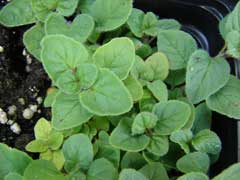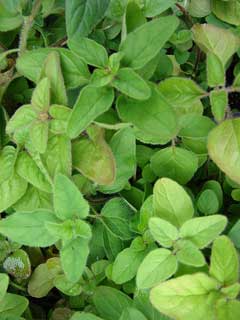 |
|
http://www.hear.org/starr/ |
 |
| http://www.hear.org/starr/ |
Translate this page:
Summary
Physical Characteristics

 Origanum x majoricum is a PERENNIAL growing to 0.6 m (2ft) by 0.5 m (1ft 8in).
Origanum x majoricum is a PERENNIAL growing to 0.6 m (2ft) by 0.5 m (1ft 8in).
See above for USDA hardiness. It is hardy to UK zone 7. It is in flower from June to September, and the seeds ripen from August to September. The species is hermaphrodite (has both male and female organs) and is pollinated by Bees.
It is noted for attracting wildlife.
Suitable for: light (sandy), medium (loamy) and heavy (clay) soils and prefers well-drained soil. Suitable pH: mildly acid, neutral and basic (mildly alkaline) soils. It can grow in semi-shade (light woodland) or no shade. It prefers dry or moist soil.
UK Hardiness Map
US Hardiness Map
Synonyms
Plant Habitats
Cultivated Beds;
Edible Uses
Edible Parts: Leaves
Edible Uses: Condiment Tea
The following uses are for O. majorana. They almost certainly also apply to this plant. Leaves - raw or cooked[2, 52]. Sweet marjoram is widely used as a flavouring for salad dressings, vegetables, legumes and oils[7, 14, 27, 61, 171, 238]. It has a more delicate flavour than the closely related oregano (Origanum vulgare), and is best when used fresh and only added towards the end of cooking[238]. The aromatic seeds are used as a flavouring in sweets, drinks etc[183]. A herb tea is made from the fresh or dried leaves[21, 183]. The flavour resembles a blend of thyme, rosemary and sage[183].
References More on Edible Uses
Medicinal Uses
Plants For A Future can not take any responsibility for any adverse effects from the use of plants. Always seek advice from a professional before using a plant medicinally.
Antiseptic Antispasmodic Aromatherapy Carminative Cholagogue Diaphoretic Disinfectant Emmenagogue
Expectorant Stimulant Stomachic Tonic
The following uses are for O. majorana. They almost certainly also apply to this plant. The herb is antiseptic, antispasmodic, carminative, cholagogue, diaphoretic, diuretic, emmenagogue, expectorant, stimulant, stomachic and mildly tonic[4, 7, 21]. It is taken internally in the treatment of bronchial complaints, tension headaches, insomnia, anxiety, minor digestive upsets and painful menstruation[238]. It should not be prescribed for pregnant women[238]. Externally, it is used to treat muscular pain, bronchial complaints, arthritis, sprains and stiff joints[238]. The plant is harvested as flowering begins and can be used fresh or dried. Marjoram is often used medicinally in the form of the essential oil, about 400 grams being obtained from 70 kilos of the fresh herb[4]. The oil is used as an external application for sprains, bruises etc[4]. The essential oil is used in aromatherapy. Its keyword is 'Muscle relaxant'[210].
References More on Medicinal Uses
The Bookshop: Edible Plant Books
Our Latest books on Perennial Plants For Food Forests and Permaculture Gardens in paperback or digital formats.

Edible Tropical Plants
Food Forest Plants for Hotter Conditions: 250+ Plants For Tropical Food Forests & Permaculture Gardens.
More

Edible Temperate Plants
Plants for Your Food Forest: 500 Plants for Temperate Food Forests & Permaculture Gardens.
More

More Books
PFAF have eight books available in paperback and digital formats. Browse the shop for more information.
Shop Now
Other Uses
Disinfectant Dye Essential
The following uses are for O. majorana. They almost certainly also apply to this plant. The leaves and flowers yield 0.3 - 0.4% essential oil by steam distillation[240]. Called 'Oil of Sweet Marjoram', it is used as a food flavouring and in perfumery, soaps, hair products etc[57, 61, 171, 238]. The plant is often used to disinfect bee hives[7].
Special Uses
Attracts Wildlife Scented Plants
References More on Other Uses
Cultivation details
Requires a rather dry, warm, well-drained soil, but is not fussy as to soil type[18], thriving on chalk[1, 37]. Prefers slightly alkaline conditions[200]. Plants are not hardy in all parts of Britain, they tolerate temperatures down to about -5°c, possibly lower if the roots are given a good mulch in the autumn[238, K]. This species is probably a hybrid between sweet marjoram (O. majorana) and Oregano (O. vulgare). It resembles O. majorana in appearance and aroma, and has the same culinary uses, but is more tolerant of British winters[238]. A good companion plant, improving the flavour of nearby plants[14, 18, 20]. The flowers are very attractive to bees[108]. Members of this genus are rarely if ever troubled by browsing deer[233].
References Carbon Farming Information and Carbon Sequestration Information
Temperature Converter
Type a value in the Celsius field to convert the value to Fahrenheit:
Fahrenheit:
The PFAF Bookshop
Plants For A Future have a number of books available in paperback and digital form. Book titles include Edible Plants, Edible Perennials, Edible Trees,Edible Shrubs, Woodland Gardening, and Temperate Food Forest Plants. Our new book is Food Forest Plants For Hotter Conditions (Tropical and Sub-Tropical).
Shop Now
Plant Propagation
Seed - this species is a sterile hybrid and so does not produce seed. If you wanted to grow it from seed then you would need to hybridise O. vulgare x O. majorana. The resulting seedlings would be rather variable. Division in March or October. Very easy, larger divisions can be planted out direct into their permanent positions. We have found that it is better to pot up the smaller divisions and grow them on in light shade in a cold frame until they are well established before planting them out in late spring or early summer. Basal cuttings of young barren shoots in June. Very easy. Harvest the shoots with plenty of underground stem when they are about 8 - 10cm above the ground. Pot them up into individual pots and keep them in light shade in a cold frame or greenhouse until they are rooting well. Plant them out in the summer.
Other Names
If available other names are mentioned here
Native Range
EUROPE: Spain (incl. Baleares), Portugal
Weed Potential
Right plant wrong place. We are currently updating this section.
Please note that a plant may be invasive in one area but may not in your area so it's worth checking.
Conservation Status
IUCN Red List of Threatened Plants Status :

Growth: S = slow M = medium F = fast. Soil: L = light (sandy) M = medium H = heavy (clay). pH: A = acid N = neutral B = basic (alkaline). Shade: F = full shade S = semi-shade N = no shade. Moisture: D = dry M = Moist We = wet Wa = water.
Now available:
Food Forest Plants for Mediterranean Conditions
350+ Perennial Plants For Mediterranean and Drier Food Forests and Permaculture Gardens.
[Paperback and eBook]
This is the third in Plants For A Future's series of plant guides for food forests tailored to
specific climate zones. Following volumes on temperate and tropical ecosystems, this book focuses
on species suited to Mediterranean conditions—regions with hot, dry summers and cool, wet winters,
often facing the added challenge of climate change.
Read More
Expert comment
Author
Cambess.
Botanical References
200
Links / References
For a list of references used on this page please go here
Readers comment
| Add a comment |
|
If you have important information about this plant that may help other users please add a comment or link below. Only comments or links that are felt to be directly relevant to a plant will be included. If you think a comment/link or information contained on this page is inaccurate or misleading we would welcome your feedback at [email protected]. If you have questions about a plant please use the Forum on this website as we do not have the resources to answer questions ourselves.
* Please note: the comments by website users are not necessarily those held by PFAF and may give misleading or inaccurate information.
To leave a comment please Register or login here All comments need to be approved so will not appear immediately.
|
Subject : Origanum x majoricum
|
|
|
|